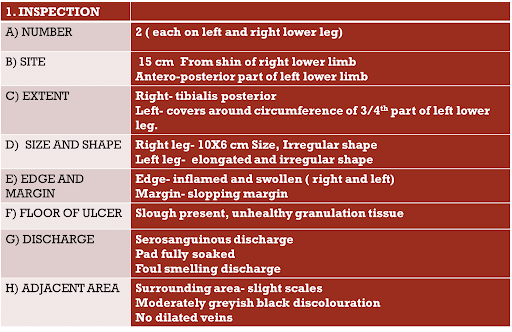Dr. Sreeshma Sreenath, BAMS,Ayur,MD, Shalyatantra, the treating physician and P N Panicker Souhruda Ayurveda Medical College deserve special recognition.
CHIEF COMPLAINT- Non-healing ulcer on both lower legs with discomfort and pus discharge for the past two and a half years.
ALROUND DATA OF THE PATIENT-
He is a 69 years old male patient.
He suffered a car accident ten years ago that resulted in a deep second degree and full thickness burn on his left lower limb caused by the bike's double silencer. He was rushed to the PRH hospital in Karamana, TVM. There were no other minor injuries, fractures, or crush injuries. The treating physician advised Autograft surgery for the burn as soon as feasible, and the physician discovered varicosity (vascular insufficiency) in the left upper thigh yet the patient was asymptomatic, proposing Stripping and Ligature treatment. Both procedures were performed in 2011, with no post-operative complications and the patient doing well. After that, the patient was healed.
- There is no family history of any inherited sickness like DM, HTN etc.
- No history of Varicose Vein (it was an asymptomatic although physician notice vascular insufficiency)
Patient appeared to be in good health prior to the onset of the sickness two and a half years ago. He was working as a cook in Snehalaya when he was hit by a broken tile, which caused discomfort and pus flow from his left leg, eventually leading to ulcer.
For this condition, he used pain relievers and even had medical treatments such as wound dressing, which was terminated after several months, but the ulcer wound was growing in size along with pain and pus discharge in his left lower leg.
Only 12 years ago, while cooking, he was burned by an oil spill in his right lower leg and got boils. He didn't care at first and even scratched the region, which resulted in the formation of a wound. The patient currently has an ulcer on both lower limbs that has grown in size and is exceedingly painful, with profuse foul-smelling discharge and interrupted sleep. He went to Shalyam OPD, PNPS AMC, with this complaint.
ASSESTMENT OF THE PATIENT-
The vitals were normal and were recorded on a regular basis beginning on the first day of hospitalisation. The patient was conscious and aware of his surroundings and time. The only thing to mention here is that the patient was anaemic. Systemic examination found no specific abnormalities.
LOCAL EXAMINATION- revealed the following on 16/01/2023
We used grading standards to see how the patient's condition improved. We have also undergone laboratory testing on occasion. The patient also received Ashtasthana and Dasavidha parekshas.
Dushta Vrana/Spreading Ulcer/Non-healing Ulcer is the diagnosis. The indications and symptoms observed in the patient, according to Vrana Adhyaya, are listed below.
- Here Amruthothara Kashayam is given in order to subside the inflammatory condition.
- Gandhaka Rasayana is given as it is Ashtadasha Kushtahara and helps in speeding up the healing process.
- Haemnoll tablet was given for anaemic condition.
PROCEDURE CARE PLAN-
- Kshalana with patolanimbadhi kashayam for 9 days.
- Bandage with betadine solution for 9 days.
- Kshalana with patoolamooladhi kashayam.
- Lepana with Yashtimadhu choorna and madhu.- Alepana of appropriate medications should be performed on newly developing swellings and wounds with acute pain. Using a medication paste reduces swelling and pain immediately. Beneficial in providing comfort. Taking care of the wound .Reduces irritated blood and pitta. Filling and healing the wound. Yashti madhu pacifies the pitta and vitiated raktha.
- Prakshalana with Triphala kashayam.
- Bandaging with jatyadhi tailm- Jatyadhi tailm is used as it helps in increasing the skin granulation, decreases the inflammatory condition.
Why prakshalana is being done?
- Prevents bacterial growth expansion.
- For the formation of collagen.
- Aids in wound healing.
- Lesion purification and healing.
- Inhibits endotoxins due to anti-inflammatory activities.
CHANGES BY TREATMENT IN RIGHT LEG

The treatment lasted 4-6 months, with strict adherence to diet and regimes. It requires more time and patience on the part of both the doctor and the patient to observe the valuable benefits. As many today expect fast results, what I want to convey is that following ayurvedic therapies takes time, especially if the condition is long-standing, and it requires strict dedication to follow this science of life. The time required to resolve the issue is determined by the patient's/disease's state, willingness of the patient, and so on. In this article, I'm merely offering a concept of structure regarding the case; there's a lot to consider and discuss completely, but owing to limitations in delivering comprehensive cases on this platform, I'll wrap this up around.
I am grateful to Dr. Sreeshma mam for allowing me to study the case she was treating and for explaining the significance of each and every step, as well as the care she does for her patients.
Dr. Thushar T S, BAMS, Ayur, MD, Kaumarabritya deserves special recognition for instilling strong desire in the students. The self-made doctor, who makes himself available to students for clarifications as needed.














Comments
Post a Comment